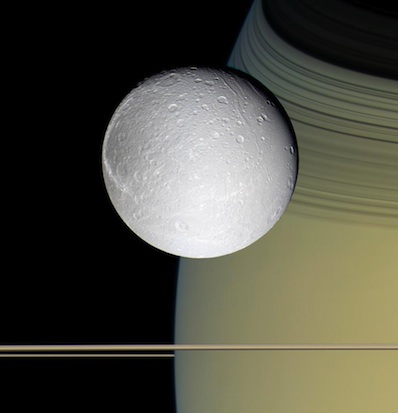Cassini detects oxygen around second Saturn moon
BY STEPHEN CLARK
SPACEFLIGHT NOW
Posted: March 4, 2012
Researchers analyzing data from NASA's Cassini spacecraft announced Friday the discovery of a tenuous atmosphere around Saturn's moon Dione, a small, colorless world of ice and rock near the giant planet's famous rings.

Cassini captured this image of Dione, backdropped by Saturn and its rings, in October 2005. Credit: NASA/JPL-Caltech/Space Science Institute
Cassini's plasma spectrometer instrument detected ions of molecular oxygen during a flyby of Dione in April 2010, and scientists announced their findings in a recent issue of the journal Geophysical Research Letters.
Dione's atmosphere is extremely thin, about 5 trillion times less dense than the atmosphere at Earth's surface. Cassini's measurements indicate there is just one oxygen ion for every 0.67 cubic inches, or 2,250 ions per cubic foot.
"We now know that Dione, in addition to Saturn's rings and the moon Rhea, is a source of oxygen molecules," said Robert Tokar, a Cassini team member based at Los Alamos National Laboratory, and the lead author of the paper. "This shows that molecular oxygen is actually common in the Saturn system and reinforces that it can come from a process that doesn't involve life."
Dione's oxygen could come from solar photons or energetic particles from space bombarding the moon's icy surface, liberating oxygen molecules, according to a NASA press release.
Scientists are also looking for other processes that could be a source of Dione's exosphere. One possible origin is geology.
Dione is believed to be about two-thirds water ice, with a dense core likely composed of silicate rock, according to NASA.
Cassini identified a thin atmosphere around Saturn's moon Rhea in 2010. With a diameter of 698 miles, Dione is slightly smaller than Rhea.
Researchers are studying data from a Cassini flyby near Dione in December in which the spacecraft's ion and neutral mass spectrometer collected data on the moon's atmosphere.
The new data could discover other molecules in Dione's atmosphere.
"Scientists weren't even sure Dione would be big enough to hang on to an exosphere, but this new research shows that Dione is even more interesting than we previously thought," said Amanda Hendrix, Cassini deputy project scientist at NASA's Jet Propulsion Laboratory. "Scientists are now digging through Cassini data on Dione to look at this moon in more detail."
Officials suspected Dione may harbor a neutral atmosphere of oxygen when the Hubble Space Telescope detected ozone.
http://spaceflightnow.com/news/n1203/04dione/
